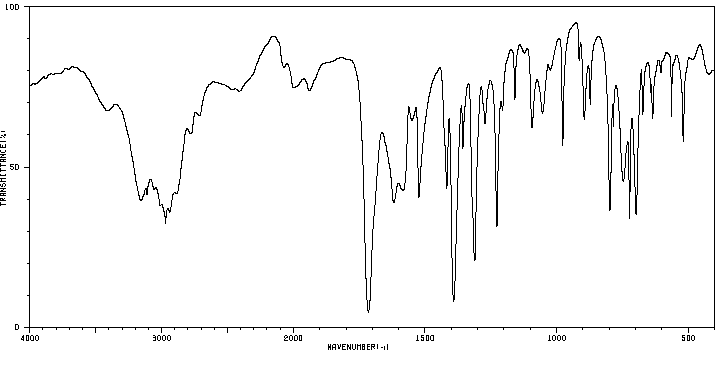9-Dicarboxymethyladenine | 34573-03-0
中文名称
——
中文别名
——
英文名称
9-Dicarboxymethyladenine
英文别名
9-Adenylmalonsaeure;(6-amino-purin-9-yl)-malonic acid;Propanedioic acid, (6-amino-9H-purin-9-yl)-;2-(6-aminopurin-9-yl)propanedioic acid
CAS
34573-03-0
化学式
C8H7N5O4
mdl
——
分子量
237.175
InChiKey
NLGWBLIQHPSNJE-UHFFFAOYSA-N
BEILSTEIN
——
EINECS
——
-
物化性质
-
计算性质
-
ADMET
-
安全信息
-
SDS
-
制备方法与用途
-
上下游信息
-
文献信息
-
表征谱图
-
同类化合物
-
相关功能分类
-
相关结构分类
计算性质
-
辛醇/水分配系数(LogP):-0.6
-
重原子数:17
-
可旋转键数:3
-
环数:2.0
-
sp3杂化的碳原子比例:0.12
-
拓扑面积:144
-
氢给体数:3
-
氢受体数:8
反应信息
-
作为产物:描述:2-(6-Amino-purin-9-yl)-malonic acid dimethyl ester 在 sodium hydroxide 作用下, 以 水 为溶剂, 以90%的产率得到9-Dicarboxymethyladenine参考文献:名称:Structure-activity studies on open-chain analogues of nucleosides: Inhibition of S-adenosyl-L-homocysteine hydrolase and antiviral activity 2. Acid open-chain analogues摘要:对腺嘌呤和其他嘌呤碱的50多个ω-羧基烷基衍生物进行了研究,以评估它们对大鼠肝S-腺苷-L-同型半胱氨酸水解酶的抑制作用和抗病毒活性。要成为SAH-水解酶的抑制剂,类似物必须在位置9处含有一个腺嘌呤碱基,该碱基被一个至少具有一个羟基功能的ω-羧基烷基(C3-C5)链所取代。侧链的绝对构型对二羟基和三羟基化合物至关重要,但对单羟基脂肪酸的重要性较小。 D-厄利他嘌呤(1a)和3-(腺嘌呤-9-基)-2-羟基丙酸(12a)是最有效的SAH-水解酶抑制剂,也是唯一具有抗病毒活性(对水疱性口炎病毒、副流感病毒3型、类风湿病毒1型和天花病毒有效)。所有这些化合物都对SAH-水解酶产生快速不可逆的失活作用。 1a和12a的酯类对酶的抑制活性很小,如果有的话;然而,它们比母体化合物1a和12a更具有强大的抗病毒作用,很可能作为后者的前药。 2-氨基-D-厄利他嘌呤,(2R,3R)-5-(腺嘌呤-9-基)-2,3-二羟基戊酸,9-(二羧甲基)腺嘌呤,4-(腺嘌呤-9-基)-2-羟基丁酸,3-(8-溴腺嘌呤-9-基)-2-羟基丙酸和9-(2,3-二羟基丙基)-和9-(2,3,4-三羟基丁基)腺嘌呤的O-羧甲基衍生物被描述为新化合物。DOI:10.1135/cccc19850262
表征谱图
-
氢谱1HNMR
-
质谱MS
-
碳谱13CNMR
-
红外IR
-
拉曼Raman
-
峰位数据
-
峰位匹配
-
表征信息
同类化合物
黄嘌呤钠盐
黄嘌呤
鸟嘌呤肟
鸟嘌呤盐酸盐
鸟嘌呤
顺式-二氨基二(O(6),9-二甲基鸟嘌呤-7)铂(II)二氯化物
顺式-2-(6-氨基-9H-嘌呤-9-基)-环己醇
阿罗茶碱
阿比茶碱
阿普西特-N-氧化物
阿昔洛韦钠
阿昔洛韦杂质K
阿昔洛韦杂质H
阿昔洛韦单磷酸盐
阿昔洛韦三磷酸酯
阿昔洛韦
阿德福韦酯杂质E
阿德福韦酯杂质12
阿德福韦酯杂质12
阿德福韦酯N6羟甲基杂质
阿德福韦酯 杂质C (阿德福韦单乙酯、单特戊酸甲酯)
阿德福韦酯
阿德福韦单特戊酸甲酯
阿德福韦-d4二磷酸三乙胺盐
阿德福韦
阿帕茶碱
阿司匹林,非那西汀和咖啡因
野杆菌素84
西潘茶碱
螺菲林
茶麻黄碱
茶苯海明
茶碱乙酸
茶碱一水合物
茶碱-D6
茶碱-8-丁酸
茶碱-2-氨基乙醇
茶碱
茶丙洛尔
苯酰胺,N-[9-[(2R)-2-羟基丙基]-9H-嘌呤-6-基]-
苯酰胺,N-(三甲基甲硅烷基)-N-[7-(三甲基甲硅烷基)-7H-嘌呤-6-基]-
苯酚,2-(3,4-二氢-2H-1-苯并吡喃-2-基)-
苯磺酸,4-(2,3,6,7-四氢-1,3,7-三甲基-2,6-二羰基-1H-嘌呤-8-基)-
苯甲酸咖啡鹼
苯甲腈,4-[(6,7-二氢-6-羰基-3H-嘌呤-3-基)甲基]-
苯呤司特
苄吡喃腺嘌呤
芬乙茶碱
芬乙茶碱
艾米替诺福韦








